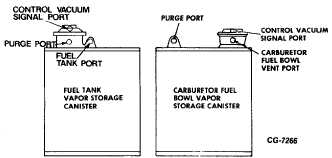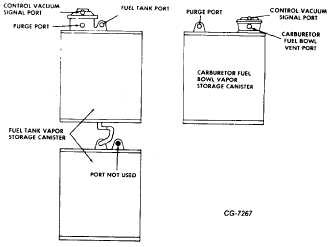|
| |
ENGINE DIVISION SERVICE MANUAL
TM 5-4210-230-14&P-1
1.
Provide space for gasoline expansion due to
temperature rise.
2.
Limit escape of gasoline vapors to the atmosphere
by collecting and storing vapors generated while
vehicle is parked with engine shut off.
3.
Burn off stored gasoline vapors when engine is
operating.
Vapor Storage Canister
When vehicle is parked and engine shut off, gasoline
vapors from the carburetor fuel bowl and the fuel tank will be
temporarily stored in the charcoal canister-until the engine is
started. When the engine is started the vapors are drawn
from the canister into the engine and burned.
When a vehicle is parked continuously for more than
one day, the odor of fuel vapors may be noticed. This is
caused by fuel vapors passing out of the canister(s) due to
oversaturation of the charcoal. Operating the engine a few
minutes will purge the canister(s) of fuel vapors and restore its
holding capacity.
Two types of vapor storage canister systems are
used in 1980 California vehicles.
Fig. 10 Vapor Storage Canisters Used on MediumHeavy
Duty Vehicles With Single Tank of 35 Gallon Capacity and
Less
1.
Two vapor storage canisters are used on medium-
heavy duty vehicles with single fuel tanks of 35
gallon capacity or less. One canister is used for
storing fuel tank vapors only. The other canister is
used for carburetor fuel bowl vapors only. This vapor
storage canister and its operation is shown in Fig.
12.
2.
Three vapor storage canisters are used on medium-
heavy duty vehicles with single fuel tank greater than
35 gallon capacity and all multi-tank vehicles. As
shown in Figure 10, the fuel tank vapor storage
canisters consist of one canister with a vacuum
controlled purge valve and one two-port canister
which is connected to the bottom of the vacuum
controlled purge canister. The two-port canister adds
vapor storage capacity for large fuel tank(s) systems.
The operation of the vacuum controlled purge
canister is shown in Figure 13.
The function of the third vapor storage canister
(shown in Fig. 11) is to store carburetor fuel bowl
vapors only. The operation of this canister is shown
in Fig. 12.
Fig. 11 Vapor Storage Canisters Used on Medium-Heavy
Duty Vehicles With Single Fuel Tank Greater Than 35 Gallon
Capacity and All Multi-Tank Installations
Canister Operation Test
Disconnect control vacuum and purge hoses from
canister(s). With engine running at high idle speed and
normal operating temperature, a vacuum pull should be felt at
each hose end. If no vacuum is felt, reconnect hoses to the
proper port on the canister(s) and disconnect at vacuum
source on engine. Inspect for obstruction in hoses and hose
connecting fittings. Also inspect hoses for cracks, damage or
deterioration and replace if necessary.
.
CGES-215 Page 10
PRINTED IN UNITED STATES OF AMERICA
|


